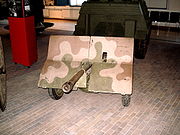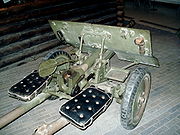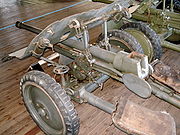
Bofors 37 mm
Encyclopedia



Sweden
Sweden , officially the Kingdom of Sweden , is a Nordic country on the Scandinavian Peninsula in Northern Europe. Sweden borders with Norway and Finland and is connected to Denmark by a bridge-tunnel across the Öresund....
manufacturer Bofors
Bofors
The name Bofors has been associated with the iron industry for more than 350 years.Located in Karlskoga, Sweden, the company originates from the hammer mill "Boofors" founded 1646. The modern corporate structure was created in 1873 with the foundation of Aktiebolaget Bofors-Gullspång...
in the early 1930s. Licensed copies were produced in a number of countries. The gun was used by some European armies during World War II, mainly at the early stage of the war.
Development history
The gun was initially designed by Swedish manufacturer Bofors, mainly for export purposes. The first prototype was built in 1932; the development process continued until 1934. The Netherlands were the first to purchase the gun (order for 12 pieces was placed in 1935) and were followed by many other countries. Licensed copies were produced Denmark, Finland, the Netherlands and Poland.The barrel
Gun barrel
A gun barrel is the tube, usually metal, through which a controlled explosion or rapid expansion of gases are released in order to propel a projectile out of the end at a high velocity....
was of monobloc type, with semi-automatic vertical sliding breech block and small muzzle brake
Muzzle brake
Muzzle brakes and recoil compensators are devices that are fitted to the muzzle of a firearm or cannon to redirect propellant gases with the effect of countering both recoil of the gun and unwanted rising of the barrel during rapid fire...
. It was mounted on a split trail carriage which had suspension and metal wheels with rubber tires. To give the crew some protection from firearms and shell fragments, the gun was equipped with a 5 mm thick shield, with a folding lower plate.
Employment history
The Bofors gun saw combat for the first time in Spanish Civil WarSpanish Civil War
The Spanish Civil WarAlso known as The Crusade among Nationalists, the Fourth Carlist War among Carlists, and The Rebellion or Uprising among Republicans. was a major conflict fought in Spain from 17 July 1936 to 1 April 1939...
, where it could easily pierce the armor of contemporary light tanks.
The Polish guns were actively used during the German
Invasion of Poland (1939)
The Invasion of Poland, also known as the September Campaign or 1939 Defensive War in Poland and the Poland Campaign in Germany, was an invasion of Poland by Germany, the Soviet Union, and a small Slovak contingent that marked the start of World War II in Europe...
and Soviet invasion of Poland in 1939
Soviet invasion of Poland
Soviet invasion of Poland can refer to:* the second phase of the Polish-Soviet War of 1920 when Soviet armies marched on Warsaw, Poland* Soviet invasion of Poland of 1939 when Soviet Union allied with Nazi Germany attacked Second Polish Republic...
. For example Wołyńska Cavalry Brigade equipped with the Bofors 37 mm antitank gun beat the German Panzer Division
Panzer Division
A panzer division was an armored division in the army and air force branches of the Wehrmacht as well as the Waffen-SS of Nazi Germany during World War II....
s in one of the first battles of the invasion; the Battle of Mokra
Battle of Mokra
The Battle of Mokra took place on September 1, 1939 near the village of Mokra, 5 km north from Kłobuck, 23 km north-west from Częstochowa, Poland...
. At that time, the armored forces of the Wehrmacht
Wehrmacht
The Wehrmacht – from , to defend and , the might/power) were the unified armed forces of Nazi Germany from 1935 to 1945. It consisted of the Heer , the Kriegsmarine and the Luftwaffe .-Origin and use of the term:...
consisted mainly of light Panzer I
Panzer I
The Panzer I was a light tank produced in Germany in the 1930s. The name is short for the German ' , abbreviated . The tank's official German ordnance inventory designation was SdKfz 101 .Design of the Panzer I began in 1932 and mass production in 1934...
and Panzer II
Panzer II
The Panzer II was the common name for a family of German tanks used in World War II. The official German designation was Panzerkampfwagen II...
tanks, which were vulnerable to the Bofors gun. Early models of the Panzer III
Panzer III
Panzer III was the common name of a medium tank that was developed in the 1930s by Germany and was used extensively in World War II. The official German designation was Panzerkampfwagen III translating as "armoured battle vehicle". It was intended to fight other armoured fighting vehicles and...
and Panzer IV
Panzer IV
The Panzerkampfwagen IV , commonly known as the Panzer IV, was a medium tank developed in Nazi Germany in the late 1930s and used extensively during the Second World War. Its ordnance inventory designation was Sd.Kfz...
could also be penetrated at ranges up to 500 m. After Poland was occupied, most of the guns fell into the hands of the German and Soviet armies. The weapon was proven obsolete by 1941 during the Operation Barbarossa
Operation Barbarossa
Operation Barbarossa was the code name for Germany's invasion of the Soviet Union during World War II that began on 22 June 1941. Over 4.5 million troops of the Axis powers invaded the USSR along a front., the largest invasion in the history of warfare...
.
Even though only one Bofors AT-gun was in action in the Invasion of Denmark, it damaged two tanks, and shoot the tracks of another tank, before its crew were either wounded or dead. A German tank destroyed and drove over the gun. The gun is now at the Tøjhusmuseet in Copenhagen.
During the Winter War
Winter War
The Winter War was a military conflict between the Soviet Union and Finland. It began with a Soviet offensive on 30 November 1939 – three months after the start of World War II and the Soviet invasion of Poland – and ended on 13 March 1940 with the Moscow Peace Treaty...
, the Finnish guns were successfully used against Soviet tanks such as T-26
T-26
The T-26 tank was a Soviet light infantry tank used during many conflicts of the 1930s as well as during World War II. It was a development of the British Vickers 6-Ton tank and is widely considered one of the most successful tank designs of the 1930s....
, T-28
T-28
The Soviet T-28 was among the world's first medium tanks. The prototype was completed in 1931 and production began in late 1932. It was an infantry-support tank intended to break through fortified defences...
and BT. However in the Continuation War
Continuation War
The Continuation War was the second of two wars fought between Finland and the Soviet Union during World War II.At the time of the war, the Finnish side used the name to make clear its perceived relationship to the preceding Winter War...
the gun was found to be ineffective against the T-34
T-34
The T-34 was a Soviet medium tank produced from 1940 to 1958. Although its armour and armament were surpassed by later tanks of the era, it has been often credited as the most effective, efficient and influential design of World War II...
and KV
Kliment Voroshilov tank
The Kliment Voroshilov tanks were a series of Soviet heavy tanks, named after the Soviet defense commissar and politician Kliment Voroshilov. The KV series were known for their extremely heavy armour protection during the early war, especially during the first year of the invasion of the Soviet...
and was relegated to an infantry support role.
The gun was used to equip the British forces
British Army
The British Army is the land warfare branch of Her Majesty's Armed Forces in the United Kingdom. It came into being with the unification of the Kingdom of England and Scotland into the Kingdom of Great Britain in 1707. The new British Army incorporated Regiments that had already existed in England...
in North Africa
North African campaign
During the Second World War, the North African Campaign took place in North Africa from 10 June 1940 to 13 May 1943. It included campaigns fought in the Libyan and Egyptian deserts and in Morocco and Algeria and Tunisia .The campaign was fought between the Allies and Axis powers, many of whom had...
, where it made up for the lack of the QF 2-pounder
Ordnance QF 2 pounder
The Ordnance QF 2-pounder was a British anti-tank and vehicle-mounted gun, employed in the Second World War. It was actively used in the Battle of France, and during the North Africa campaign...
anti-tank guns after the Fall of France. It was often carried portee
Portee
A portee is a truck that carries a gun on its bed, such that the gun is not affixed permanently to the vehicle, can be quickly unloaded, and can be fired from the truck....
on the back of a vehicle.
Bofors guns were also employed in World War II by Germany, the Netherlands, Romania, Yugoslavia and USSR, but there are no detailed reports of their use.
Summary
When it was introduced, the Bofors 37 mm anti-tank gun was an effective weapon, able to deal with contemporary tanks. Its performance, light weight and high rate of fire made it a popular anti-tank weapon in the pre-war Europe. However, introduction of better armored tanks early in World War II made the gun obsolete (as it made obsolete other similarly performing weapons such as the German PaK 36PaK 36
The Pak 36 was a German anti-tank gun that fired a 3.7 cm calibre shell. It was the main anti-tank weapon of Wehrmacht infantry units until 1942...
and the US 37mm M3
M3 37 mm gun
The 37 mm Gun M3 was the first dedicated anti-tank gun fielded by United States forces. Introduced in 1940, it became the standard anti-tank gun of the U.S. infantry with its size enabling it to be pulled by a jeep...
.
Ammunition
- Ammunition: AP with tracer, HE, WP incendiaryIncendiary ammunition-World War I:One of the first uses of incendiary ammunition occurred in World War I. At the time, phosphorus—the primary ingredient in the incendiary charge—ignited upon firing, leaving a trail of blue smoke. They were also known as 'smoke tracer' for this reason. The effective range of...
- Projectile weight (AP): 0.70 kg
- Penetration (AP shell, meet angle 60 degrees):
- 300 yards: 40 mm
- 457 yards: 33 mm
- 600 yards: 30 mm
- 900 yards: 20 mm
- 1,200 yards: 15 mm
Operators
: A version with slightly more powerful cartridge was manufactured by the Danish state arsenal Hærens Vaabenarsenal, as 37 mm Fodfolkskanon m1937. In 1945 Danish units returning to their homeland brought with them a few Swedish model 1938 guns.: As 37 PstK/36. 114 pieces were bought from Bofors in 1938-39 (some of them were returned to Sweden in 1940), 42 Polish-made guns were received from Germans in 1940-41 and 355 were produced by local manufacters Tampella and VTT (Valtion Tykkitehdas - State Artillery Factory) in 1939-41. When the Winter War
Winter War
The Winter War was a military conflict between the Soviet Union and Finland. It began with a Soviet offensive on 30 November 1939 – three months after the start of World War II and the Soviet invasion of Poland – and ended on 13 March 1940 with the Moscow Peace Treaty...
began in November 1939, the Finnish Army had 98 guns of the type. A tank version was also used to equip Finnish 6-tonne tanks. The gun remained in the Finnish Army inventory listings until 1986.
 Germany: Used Polish guns captured in 1939
Germany: Used Polish guns captured in 1939Invasion of Poland (1939)
The Invasion of Poland, also known as the September Campaign or 1939 Defensive War in Poland and the Poland Campaign in Germany, was an invasion of Poland by Germany, the Soviet Union, and a small Slovak contingent that marked the start of World War II in Europe...
as 3,7 cm PaK 36(p) and Danish guns captured in 1940
Operation Weserübung
Operation Weserübung was the code name for Germany's assault on Denmark and Norway during the Second World War and the opening operation of the Norwegian Campaign...
as 3,7 cm PaK 157(d).
: 12 pieces were ordered from Bofors in 1935; in addition, a locally produced version existed.
: As wz.36. 300 guns were bought in Sweden and hundreds more were produced by SMPzA (Stowarzyszenie Mechaników Polski z Ameryki) in Pruszków
Pruszków
Pruszków is a town in central Poland, situated in the Masovian Voivodeship since 1999. It was previously in Warszawa Voivodeship . Pruszków is the capital of Pruszków County, located along the western edge of the Warsaw urban area...
, some of them exported. When World War II began, the Polish Army had 1,200 pieces. A tank variant, designated wz.37, was mounted in 7TP
7TP
The 7TP was the Polish light tank of the Second World War. A development of the British Vickers 6-ton, it was significantly better armed than its most common opponents, the German Panzer I and Panzer II. A standard tank of the Polish Army during the Polish Defensive War of 1939, its production...
(single-turret version), 9TP (prototypes) and 10TP
10TP
The 10TP was a Polish light cruiser tank that never left the prototype status. While advancing the Polish armour development programme, the prototype was deemed unsuccessful...
tanks. 111 of them were produced before the war.
: 556 pieces (former Polish ones) were bought from Germany.
: Some guns bought by the Republicans were used during the Spanish Civil War.
: Adopted in 1937 as 37 mm infanterikanon m/34 (infantry gun model 1934). Modernized version was adopted in 1938 as 37 mm pansarvärnskanon m/38 (anti-tank gun model 1938) and 37 mm pansarvärnskanon m/38 F. The latter was also produced in a tank gun variant - 37 mm Kanon m/38 stridsvagn; it was fitted to Landsverk
AB Landsverk
Landsverk was founded in 1872 as Firman Petterson & Ohlsen. It was a heavy industry, manufacturingrailroad cars, harbour cranes and agricultural machinery. It was located in Landskrona, Sweden.-Early days:...
Strv m/38, Strv m/39, Strv m/40 light tanks and to the Strv m/41, a Swedish version of the Czech TNH
Panzer 38(t)
The Panzerkampfwagen 38 was originally a Czech tank of pre-World War II design. After Czechoslovakia was taken over by Germany, it was adopted by the German Army, seeing service in the invasions of Poland and Russia. Production ended in 1942, when its armament was deemed inadequate. In all, over...
light tank.
: A number of Swedish m/34 ordered by Anglo-Egyptian Sudan
Anglo-Egyptian Sudan
Anglo-Egyptian Sudan referred to the manner by which Sudan was administered between 1899 and 1956, when it was a condominium of Egypt and the United Kingdom.-Union with Egypt:...
were adopted as Ordnance QF 37 mm Mk I.
: Several dozens of Polish guns fell into Soviet hands. Late in 1941 these pieces were issued to Red Army
Red Army
The Workers' and Peasants' Red Army started out as the Soviet Union's revolutionary communist combat groups during the Russian Civil War of 1918-1922. It grew into the national army of the Soviet Union. By the 1930s the Red Army was among the largest armies in history.The "Red Army" name refers to...
units to make up for the lack of anti-tank guns.

